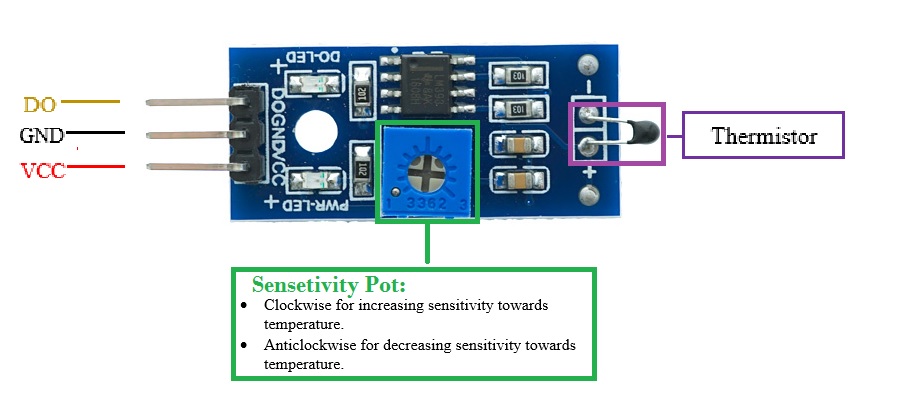AED 5.25
Description
The Analog Temperature Sensor module with Schmit Trigger is a sensor module based on the thermistor's resistance on the board, it can sense the ambient temperature it has an operating Voltage of 5V and the temperature measurement range is from 20 °c to 80 °c with measurement Accuracy of ±0.5°C. you can work with this module without the need for MCU.
Package Includes:
- 1x NTC Temperature Analog Sensor Module with Schmit Trigger Blue
Features:
- Thermistor cost is economical
- Output: Analog and Digital
- Sensitivity Adjustable
- 2 LED OnBoard (Power and D0 LED Schmitt related to the Cut off Point)
- Provided with lacquer-coated thermistor disk
- Copper leads have a coating of tin.
- Onboard resistors, no need for external components
- The working voltage is DC 3.3V-5V
- The output is digital switching (outputs ( 0 and 1 ))
- Fixed bolt holes for easy installation
- Uses LM393 comparator
- Good stability, and durability in the environment
- Provide high accuracy in resistance and B-constant
Description:
The Analog Temperature Sensor module with Schmit Trigger is a sensor module based on the thermistor's resistance on the board, it can sense the ambient temperature it has an operating Voltage of 5V and the temperature measurement range is from 20 °c to 80 °c with measurement Accuracy of ±0.5°C. you can work with this module without the need for MCU.2. Thermistors are straightforward and reasonably priced, The use of thermistors would be best in home automation systems, and equipment control and protection circuits.
Principle of Work:
The resistance of thermometers, which are variable resistors, varies with temperature. They are categorized based on how they react to temperature changes in terms of resistance. Resistance decreases as temperature rises in thermistors with a negative temperature coefficient (NTC). The most popular thermistors are NTC ones. NTC thermistors are created by heating and compressing a semiconducting material (like metal oxide or ceramic) to create a temperature-sensitive conducting material. Charge carriers in the conducting material enable current to pass through it. The semiconducting material releases more charge carriers when the temperature is elevated. Electrons are the charge carriers in ferric oxide-based NTC thermistors. Electron holes serve as the charge carriers in nickel oxide NTC thermistors.
Pinout of the Board:


Applications:
- Domestic application – Fridges, freezers, cookers and deep-fat fryers, etc.
- Thermistors can be used for temperature compensation, temperature measurement, and temperature control.
Circuit:
D0 pin to signal in on your relay
GND pin to GND on the relay
VCC pin to VCC on relay
connect all VCC to 5V VCC
Connect GND of relay and Module to the lower power source GND
you can connect any load to the relay AC or DC

Library:
you don't need any library to work with this sensor.
Code:
no need for code we didn't use Any MCU in this tutorial
Technical Details:
- Resistance at 25 degrees C: 10K +- 1%
- B-value (material constant) = 3950+- 1%
- Dissipation factor (loss-rate of energy of a mode of oscillation) δ th = (in the air)approx.7.5mW/K
- Thermal cooling time constant <= (in the air) 20 seconds
- Thermistor temperature range from -20 °c to 80 °c
- Input Voltage: DC 3.3V to 5V
- Size: 32mm x 14mm x 5mm
Resources:
Comparisons:
thermometers are very cheap, but imprecise, and their resistance changes with temperature in a non-linear manner, determining the temperature requires a little "work" on your software's part. Although more expensive, active devices like the LM35 are more accurate and provide a linear voltage-vs-temperature characteristic, making it simpler to determine the temperature. this module has only digital out with the help of a Schmitt trigger circuit so there is no analog output you can use it to determine the temperature with the microcontroller only you can use the pot on the board so if you need the analog out you can use this module, but still, this module can work without the need of any MCU.